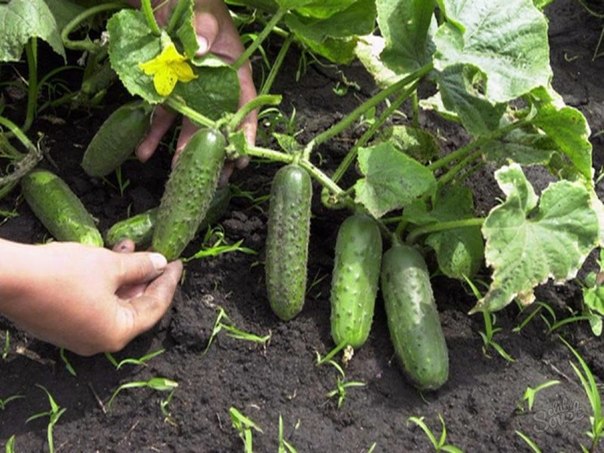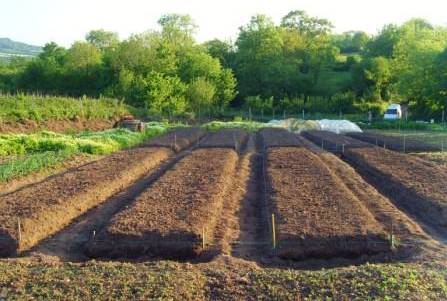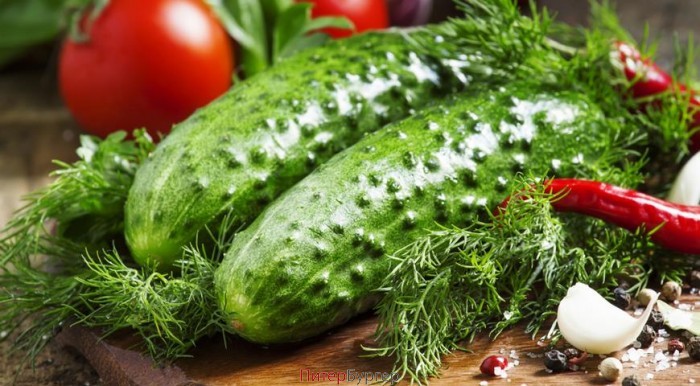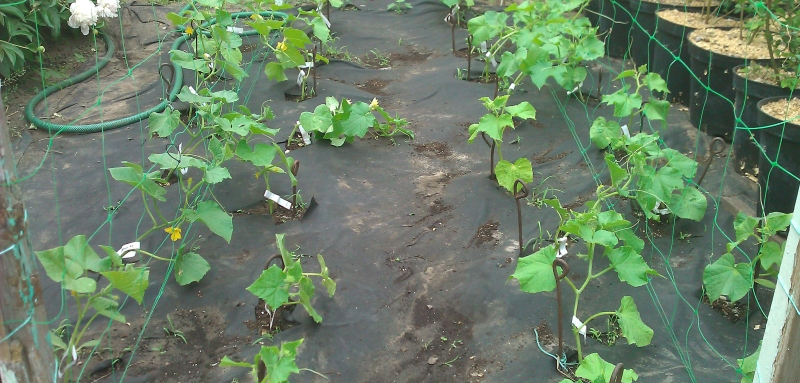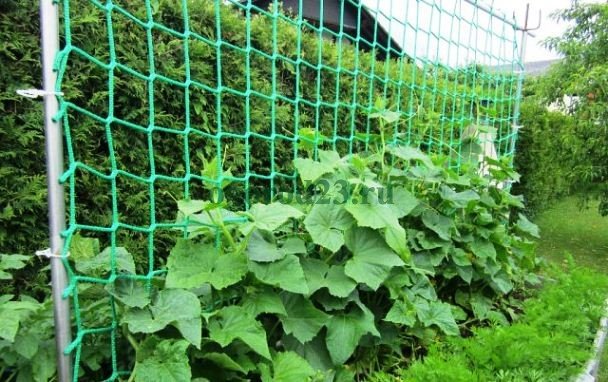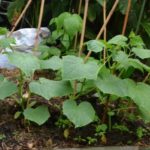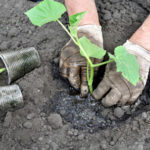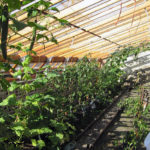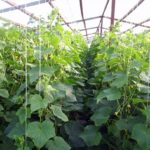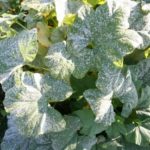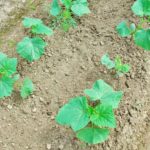Since cucumbers are a fairly popular crop in our gardens, it is worth considering the features of caring for this vegetable in the climate near Moscow. Let's look at how to plant seedlings correctly and describe the main points of caring for vegetables in order to ultimately get abundant and tasty fruits of your labor.
Where and how best do cucumbers grow?
Their seeds are sown next to cabbage and peas in the ground, but should not be planted near potatoes. It is recommended to plant beans or corn on all sides of the beds with cucumber bushes.Beans will protect young plants, and corn will protect the grown crop.
Beans tolerate cold weather well; they are planted even earlier than cucumbers in 2 rows, keeping a distance of 0.15 m between rows. Corn is planted at the same time as cucumbers - in 2 rows. It is even better to sow beans and corn across the direction of the winds.
To understand how to grow a crop, you need to know that seeds are sown in the place where tomatoes, peas, peppers, cabbage, and onions previously grew.
To grow cucumbers, they should never be planted after beans or carrots, as these crops suffer from white rot, which also affects cucumbers.
Landing site requirements
To sow cucumber seeds, select a well-lit area with light soil, without north winds.
You can buy cucumber seedlings and plant them, but do not forget that cucumbers grow normally at a temperature of 18 - 26 ° C. If the temperature drops to 15 °C, the crop slows down its growth. If the temperature drops below 10 °C, the cucumbers will completely stop growing, diseases will appear on the roots and root collar, and then the crop will die.
When the temperature drops to 10 °C, cover the plants with film.
When to plant cucumbers in the Moscow region? The dates for planting seeds are from May 20 to June 20.
Soil preparation
Planting cucumbers in open ground is done in 5 ways:
- in trenches;
- in beds insulated with straw and grass;
- in warm beds of manure;
- on artificial slopes;
- growing cucumbers in a barrel.
Digging a trench
In the fall, dig a strip 0.7 m wide and 0.2 m deep. Dig a trench 0.3 m deep in the center of the strip. Place a 15 cm layer of chopped straw, fallen leaves, mowed weeds, and peat at the bottom of the trench.At the beginning of spring, add a 0.25 m layer of fresh manure into the trench. Pour boiling water over the manure, adding potassium permanganate to the boiling water. Sprinkle soil on top.
Warm bed
In autumn, sprinkle 6–8 kg of rotted manure onto 1 m² of land. Dig to the depth of a shovel - this is about 30 cm.
Fold the top layer of soil to the side, add mowed grass, chopped straw, fallen leaves, and sawdust to the bottom. Fill with soil so that the height of the bed is 0.5 m. Pour boiling water over it, sprinkle with crushed chalk and ash on top. Cover with film and let it sit for 24 hours. Next, add a substrate of peat, humus and sawdust. Cover again with film and leave until spring.
Warm bed of manure
In the fall, pour a layer of soil on the pile of manure, and then cover it with burlap and plastic wrap - then the manure will not freeze in the cold season. In very early spring, when there is still snow, remove the burlap and film.
Dig up the manure so that oxygen reaches it, then it will warm up to a temperature of +60 ° C due to the active proliferation of bacteria. You can also add hot bricks to the pile.
When the soil thaws, a layer of soil is removed from the bed to a depth of 40 cm. A layer of 10 cm of sawdust is poured down, watered with urea solution, and manure is placed on top. Almost 1 ton of manure is used per 3 m². Then a previously removed layer of fertile soil 0.25 m thick is placed on it and the ground is covered with black polyethylene.
Artificial slope
You can plant cucumbers on artificially formed slopes. Pour the earth so that on the north side there is a steep slope 0.2 - 0.25 m high, and on the south side there is a gentle slope. Make the bed 1 m wide. Dig shallow holes in the middle of the bed. We sow seeds in them.
Barrel
Very early in the spring, 1/3 of the barrel is filled with branches, pieces of rags, and dried roots. Then another 1/3 of weeds, vegetation residues, potato peels, onion peels.
Then place the barrel in the sun and leave it for 3 weeks, watering it. "Baikal EM" accelerates the rotting of weeds. Add 100 ml of Baikal EM to a ten-liter bucket of settled water and pour into a barrel.
From May 1, add a 20 cm layer of soil from humus, leaf and ordinary soil. The ground is watered with a boiling pinkish solution of potassium permanganate. 10 seeds are placed in a barrel. Cover the barrel with film before you see the first leaves. Barrel sprouted buds can be protected by covering them with plastic bottles.
The most suitable varieties of cucumbers
It is necessary to plant cucumbers in open ground in the Moscow region by selecting varieties according to the following principles:
- It is better to plant early ripening cucumbers.
- It is preferable to select those that pollinate themselves, since if the weather is cool, then few pollinating insects fly.
- Select varieties that do not respond to sudden changes in temperature, produce high yields in the absence of light and heat, and in dense plantings.
- Having immunity to diseases and being poorly affected by pests.
To obtain an excellent harvest of cucumbers in the Moscow region, it is recommended to plant 3 to 7 varieties per garden plot, alternating parthenocarpic (self-pollinating) and pollinated by all sorts of wasps and bees.
The following are planted in open ground with seeds in the Moscow region:
- varieties: Vyaznikovsky, Alex, Urozhayny 86, Opera, Melodies, Soyuz, Angelina, Nezhinsky local, Ajax, Competitor, Nerosimy 40, Golubchik, Altai early, Atlantis;
- hybrids: Rodnichok, Magnificent, Masha, MOVIR, German, State Farm, Claudia, VIR 505, Farmer, Annushka, Blizzard, Stork, Crane, At the behest of a pike, Nightingale, Petersburg Express, Snowstorm, Cellar, Santana, Libelle.
Planting seeds
Before planting cucumbers, the seeds are placed in a gauze bag. Place the bags near the radiator. Warm up for 2 months. The best temperature is 20 °C.
Cucumber seeds are soaked 3–6 days before placing them in the soil and left in a warm room until they hatch. The seeds are hardened to increase the future yield and speed up the ripening of cucumbers:
- First, the seeds are kept in the heat for 6 hours, then in the refrigerator for 6 hours.
- The seeds are kept for 2 days at a temperature of 2 °C.
- When the seeds hatch, they are kept for 1 day at a temperature of 1°C.
If you bought seeds in a multi-colored shell, then you do not need to soak them and germinate them.
To guarantee sprouting, take 3 types of seeds: completely dry, already sprouted and soaked in water. If you sow sprouted seeds, they will sprout before everyone else, but may die when frost returns. Seeds soaked in water have average resistance to frost, but germinate early. Dry seeds are most resistant to frost, but, of course, sprouts from them will appear much later.
Plant by making holes at a distance of 0.6 m from one another, if you are making 1 row. If you plant in 2 rows, then maintain a distance of 0.8 - 0.9 m between holes and 0.4 - 0.5 m between rows. Sowing cucumbers in open ground with seeds is done by placing seeds of all three types into the holes to a depth of 1 - 2 cm. Sprinkle moistened soil on top and press it down a little.
Do I need to water the beds after placing the seeds in the ground? No, because the water will displace the air and oxygen will not reach the seeds.
Before the sprouts grow, you can apply peat mulch. When mulching, the earth cools down more slowly, the air near the ground is warmer due to the dark color of the peat, because of this it is warmed up by the sun faster, and the moisture dries out more slowly. Or cover the bed with a polyethylene film, then a crust will not form on the soil. If there is sun all day, then grass and straw are scattered over the film. When the first shoots appear, the film is removed.
Care
Let's look at the main stages of caring for a vegetable.
Thinning
The subtlety of caring for bushes is when sprouts appear, they are thinned out by pinching them off. You should not pull out seedlings with roots, as this can damage other bushes.
The seedlings are thinned out for the first time when 1 true leaf grows. Leave 1 sprout every 0.1 m. The second - when the third true leaf appears, make a distance of 0.5 m between the sprouts. After thinning, the bushes are slightly hilled, then the moisture will not remain for long near the sprouts, and they will not rot.
Top dressing
Since April 29, seedlings have been watered with solutions from “Sudarushka” and “Bucephalus”. In the spring, for more intensive leaf growth, cucumber plantings are watered with a urea solution, diluting 2 tbsp. spoons in a ten-liter bucket of water.
When growing bushes, they are fertilized once a week - this is done after watering. For fertilizing, you can dilute 1 part of chicken or rabbit droppings with 5 parts of water, or take 1 part of manure and 5 parts of water, and leave for a couple of days. Then add another ten-liter bucket of water to each liter of infusion. 1 - 2 liters are poured under the bush.
You can feed it every other time, first with mullein, then with a solution of Agricola, Effekton, and Energen fertilizers.
From mid-summer, the bushes are fed with a solution of 3 tbsp. spoons of potassium nitrate and a ten-liter bucket of water.
Watering
Water cucumbers in open ground with warm, settled water three or four times a week. Water at the root so that the droplets do not fall on the stems and leaves, otherwise the plant may get downy mildew. In the morning, spray the bushes with a spray bottle, pouring a small amount of warm water into it. If there is no rain, water more often. When it's hot, water with a hose. After watering or rain, loosen the soil.
To attract pollinating insects, when flowering, make a syrup from 1 tbsp. spoons of honey and 0.5 liters of water and sprinkle it. You also need to know that in order to attract insects, coriander seeds should be planted between the rows in early spring.
Formation
For the prevention of diseases due to fungi growing cucumbers on a trellis. Growing cucumbers on a trellis saves a lot of space. Drive poles into the garden bed, maintaining a distance of 0.7 - 0.8 m, tie wire trellises to them, and make a space between the bushes of 0.3 - 0.4 m.
You can replace the trellis wire with a wooden lath, which you nail to the support posts at the top - then the lath will not sag like the wire.
When growing, pinch the stem above 4 to 5 leaves. This is done for all varieties of cucumbers, in addition to hybrid and Altai early. When pinched, the stem stops growing in length, but side shoots begin to grow, and female flowers bloom on them.
Branches that grow on lateral branches pinch the first cucumber. Trim off dried and yellow leaves. All this is done in the morning so that the resulting media dries out by the evening.
When to pick fruits
Cucumbers that are planted in the Moscow region begin to be harvested at the end of July. From grown cucumber bushes collected early in the morning once every 2-3 days, then every other day. In the morning, the cucumbers are carefully torn off from the growing vines, trying not to tug at the vines. You cannot shift the lashes when collecting fruits. You should not leave large yellow cucumbers on the bushes, otherwise the bush will receive a signal that the seeds have grown and it is time to stop growing.
Growing cucumbers in open ground in the Moscow region has its own nuances, but in any case, plantings require watering, fertilizing, pulling out weeds, and loosening the soil after each watering and rain.

